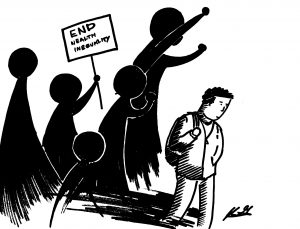
What do we want? To reduce the wealth gap! When do we want it? Now!
The “Occupy” movement, which has taken over many of America’s economic centers, claims to represent 99 percent of the population in the fight against wealth inequality. Until recently, the movement was a cute diversion from the doldrums of everyday life. Wall Street protesters seemed to represent a reasonably average cross-section of the American public, with the occasional whacked-out hippie thrown in. They set up tents in public parks and even devised their own form of communication, largely comprised of hand gestures and finger wiggles.
However, the movement took a turn for the worse with “Occupy Oakland.” The Oakland movement, a continuation of the “99 percent” protests, began much like the other peaceful demonstrations. Yet after only a few days, violent clashes between protesters and the police resulted in serious injuries. On October 25th, at least 3 were injured by the tear gas and fireworks thrown by the police and protesters, respectively. The Oakland protests have slowly revealed the darker side of the “Occupy” movements.
In fact, MVHS students have particular reason to fear the Oakland movements; the 2000 Census Demographic places Cupertino in the top 100 wealthiest cities with a population of over 10,000. Or in plainer terms, in the “one percent.” While it is true that not all residents of the city are rich enough to belong to the “one percent,” it is undeniable that the community as a whole is well-off. With a violent movement so nearby protesting the “wasteful splendor” of our existence, it is a wonder more students haven’t cried out against the protests.
The families of MVHS students need to protect the social position they have worked so hard to reach. Despite being members of the vilified “one percent,” it was effort and dedication, not underhanded business practices, that brought many MVHS parents to their current place in society. According to the school’s own demographic profile, over 75 percent of students come from immigrant backgrounds; the hard work that previous generations put in for a chance to come to the United States should be rewarded, not punished.
Demonizing the top one percent of Americans actually demonizes achievement. By punishing and protesting the success of rich Americans, protesters are actually fighting against the fruits of the very social mobility that they want increased access to. In fact, the cries for wealth redistribution ring eerily similar to the demands of Marx’s revolting proletariat in a Communist revolution.
MVHS students also need to condemn the protests to protect the truth. The “99 percent” movement’s propoganda system paints the “one percent” as decadently rich and greedy. However, these are blatant exaggerations. Most of the three million members of the top one percent of America do not lobby the government for increased protection, take advantage of tax loopholes or live in the lap of luxury. Residents of Cupertino need only look to their own lives to realize this; students save for college, housing values are watched closely by all and many parents face financial troubles of their own. While protesters may use the phrase “one percent” to represent the Wall-Street bankers they are really after, the term and the connotations of evil that come with it are unfair to the vast majority of the one percent.
MVHS may reside in one of America’s richest cities, but this does not make its students greedy or manipulative citizens. The members of “Occupy Oakland” may malign successful cities, but students and their families should stand up against the movement to protect what they have rightfully earned.







